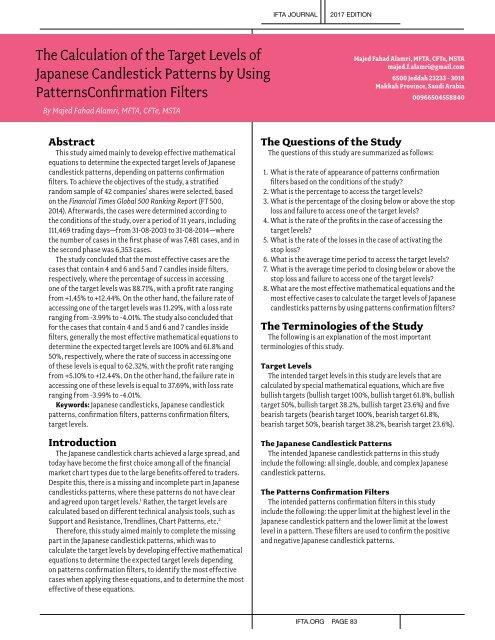You also want an ePaper? Increase the reach of your titles
YUMPU automatically turns print PDFs into web optimized ePapers that Google loves.
IFTA JOURNAL<br />
2017 EDITION<br />
The Calculation of the Target Levels of<br />
Japanese Candlestick Patterns by Using<br />
PatternsConfirmation Filters<br />
By Majed Fahad Alamri, MFTA, CFTe, MSTA<br />
Majed Fahad Alamri, MFTA, CFTe, MSTA<br />
majed.f.alamri@gmail.com<br />
6500 Jeddah 23233 - 3018<br />
Makkah Province, Saudi Arabia<br />
00966504558840<br />
Abstract<br />
This study aimed mainly to develop effective mathematical<br />
equations to determine the expected target levels of Japanese<br />
candlestick patterns, depending on patterns confirmation<br />
filters. To achieve the objectives of the study, a stratified<br />
random sample of 42 companies’ shares were selected, based<br />
on the Financial Times Global 500 Ranking Report (FT 500,<br />
2014). Afterwards, the cases were determined according to<br />
the conditions of the study, over a period of 11 years, including<br />
111,469 trading days—from 31-08-2003 to 31-08-2014—where<br />
the number of cases in the first phase of was 7,481 cases, and in<br />
the second phase was 6,353 cases.<br />
The study concluded that the most effective cases are the<br />
cases that contain 4 and 6 and 5 and 7 candles inside filters,<br />
respectively, where the percentage of success in accessing<br />
one of the target levels was 88.71%, with a profit rate ranging<br />
from +1.45% to +12.44%. On the other hand, the failure rate of<br />
accessing one of the target levels was 11.29%, with a loss rate<br />
ranging from -3.99% to -4.01%. The study also concluded that<br />
for the cases that contain 4 and 5 and 6 and 7 candles inside<br />
filters, generally the most effective mathematical equations to<br />
determine the expected target levels are 100% and 61.8% and<br />
50%, respectively, where the rate of success in accessing one<br />
of these levels is equal to 62.32%, with the profit rate ranging<br />
from +5.10% to +12.44%. On the other hand, the failure rate in<br />
accessing one of these levels is equal to 37.69%, with loss rate<br />
ranging from -3.99% to -4.01%.<br />
Keywords: Japanese candlesticks, Japanese candlestick<br />
patterns, confirmation filters, patterns confirmation filters,<br />
target levels.<br />
Introduction<br />
The Japanese candlestick charts achieved a large spread, and<br />
today have become the first choice among all of the financial<br />
market chart types due to the large benefits offered to traders.<br />
Despite this, there is a missing and incomplete part in Japanese<br />
candlesticks patterns, where these patterns do not have clear<br />
and agreed upon target levels. 1 Rather, the target levels are<br />
calculated based on different technical analysis tools, such as<br />
Support and Resistance, Trendlines, Chart Patterns, etc. 2<br />
Therefore, this study aimed mainly to complete the missing<br />
part in the Japanese candlestick patterns, which was to<br />
calculate the target levels by developing effective mathematical<br />
equations to determine the expected target levels depending<br />
on patterns confirmation filters, to identify the most effective<br />
cases when applying these equations, and to determine the most<br />
effective of these equations.<br />
The Questions of the Study<br />
The questions of this study are summarized as follows:<br />
1. What is the rate of appearance of patterns confirmation<br />
filters based on the conditions of the study?<br />
2. What is the percentage to access the target levels?<br />
3. What is the percentage of the closing below or above the stop<br />
loss and failure to access one of the target levels?<br />
4. What is the rate of the profits in the case of accessing the<br />
target levels?<br />
5. What is the rate of the losses in the case of activating the<br />
stop loss?<br />
6. What is the average time period to access the target levels?<br />
7. What is the average time period to closing below or above the<br />
stop loss and failure to access one of the target levels?<br />
8. What are the most effective mathematical equations and the<br />
most effective cases to calculate the target levels of Japanese<br />
candlesticks patterns by using patterns confirmation filters?<br />
The Terminologies of the Study<br />
The following is an explanation of the most important<br />
terminologies of this study.<br />
Target Levels<br />
The intended target levels in this study are levels that are<br />
calculated by special mathematical equations, which are five<br />
bullish targets (bullish target 100%, bullish target 61.8%, bullish<br />
target 50%, bullish target 38.2%, bullish target 23.6%) and five<br />
bearish targets (bearish target 100%, bearish target 61.8%,<br />
bearish target 50%, bearish target 38.2%, bearish target 23.6%).<br />
The Japanese Candlestick Patterns<br />
The intended Japanese candlestick patterns in this study<br />
include the following: all single, double, and complex Japanese<br />
candlestick patterns.<br />
The Patterns Confirmation Filters<br />
The intended patterns confirmation filters in this study<br />
include the following: the upper limit at the highest level in the<br />
Japanese candlestick pattern and the lower limit at the lowest<br />
level in a pattern. These filters are used to confirm the positive<br />
and negative Japanese candlestick patterns.<br />
IFTA.ORG PAGE 83


